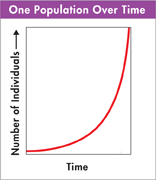5 Assessment
5.1 How Populations Grow
Understand Key Concepts
The number of individuals of a single species per unit area is known as
carrying capacity.
logistic growth.
population density.
population growth rate.
The movement of individuals into an area is called
demography.
carrying capacity.
immigration.
emigration.
The area inhabited by a population is known as its
growth rate.
geographic range.
age structure.
population density.
The graph below represents
carrying capacity.
exponential growth.
logistic growth.
age structure.

The maximum number of organisms of a particular species that can be supported by an environment is called
logistic growth.
carrying capacity.
exponential growth.
population density.
What is the difference between immigration and emigration?
Sketch the exponential growth curve of a hypothetical population.
Describe the conditions under which logistic growth occurs.
What is carrying capacity? Give an example.
Think Critically
Use Analogies How is the carrying capacity of a city's roads similar to the carrying capacity of an ecosystem?
5.2 Limits to Growth
Understand Key Concepts
A limiting factor that depends on population size is called a
density-dependent limiting factor.
density-independent limiting factor.
predator-prey relationship.
parasitic relationship.
One example of a density-independent limiting factor is
predation.
hurricanes.
competition.
parasitism.
How might increasing the amount of a limiting nutrient in a pond affect the carrying capacity of the pond?
Describe the long-term effects of competition on populations of two different species competing for the same resources.
Describe how a predator-prey relationship can control both the predator population and the prey population.
How do parasites serve as a density-dependent limiting factor?
Think Critically
What would happen to a population of predators if there was a sudden increase in food for the prey? Explain your answer.
Apply Concepts Why would a contagious virus that causes a fatal disease be considered a density-dependent limiting factor?
Table of Contents
- Formulas and Equations
- Applying Formulas and Equations
- Mean, Median, and Mode
- Estimation
- Using Measurements in Calculations
- Effects of Measurement Errors
- Accuracy
- Precision
- Comparing Accuracy and Precision
- Significant Figures
- Calculating With Significant Figures
- Scientific Notation
- Calculating With Scientific Notation
- Dimensional Analysis
- Applying Dimensional Analysis




